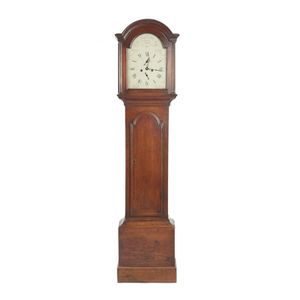18th Century Oak Longcase Clock with Bell Strike Movement
You must be a subscriber, and be logged in to view price and dealer details.
Subscribe Now to view actual auction price for this item
When you subscribe, you have the option of setting the currency in which to display prices to $Au, $US, $NZ or Stg.
- Movement - The technical name for the workings of a clock or watch, and does not include the dial or case.
- Oak - Native to Europe and England, oak has been used for joinery, furniture and building since the beginning of the medieval civilisation. It is a pale yellow in colour when freshly cut and darkens with age to a mid brown colour.
Oak as a furniture timber was superceded by walnut in the 17th century, and in the 18th century by mahogany,
Semi-fossilised bog oak is black in colour, and is found in peat bogs where the trees have fallen and been preserved from decay by the bog. It is used for jewellery and small carved trinkets.
Pollard oak is taken from an oak that has been regularly pollarded, that is the upper branches have been removed at the top of the trunk, result that new branches would appear, and over time the top would become ball-like. . When harvested and sawn, the timber displays a continuous surface of knotty circles. The timber was scarce and expensive and was used in more expensive pieces of furniture in the Regency and Victorian periods. - Spandrel - An architectural term that in horology refers to the triangular ornamental decoration in the corners of of the dial plate. The spandrels are usually of cast brass and may be additonally chased and engraved. On painted dial clocks the spandrels are also usually painted.
- Chapter Ring - A separate metal plate on the face of a clock, on which the numerals for the hours and sometimes parts of the hours, are displayed, usually wheel shaped and sitting on top of the dial plate. The chapter ring is often a feature of the clock and can be silvered or enamelled to stand as a contrast to its background. The hours are usually shown in Roman numerals, although in the late 19th and earlt 20th century, Arabic numerals became fashionable.
This item has been included into following indexes:
Visually similar items

A fine early 18th century matched walnut veneer longcase clock by Martin Jackson, London. C.1715. Rare five pillar month duration movement with pull repeat. Brass dial with silverd chapter ring, cherub spandrels, box calendar and ringed winding holes. Heav

Long case clock, Henry Jones, oak 31 day with pendulum and weights, height 190 cm

A George III oak longcase clock. Maker: Robert Vernon. The silvered arch dial with ormolu surround, eight day anchor escapement and a striking on a bell. 215 cm high, 53 cm wide

A 19th century oak longcase clock the arch top flanked by reeded pillars, the painted and gilded face named Woodcock, Colchester. Height 220 cm. Width 46.5 cm. Depth 27 cm
